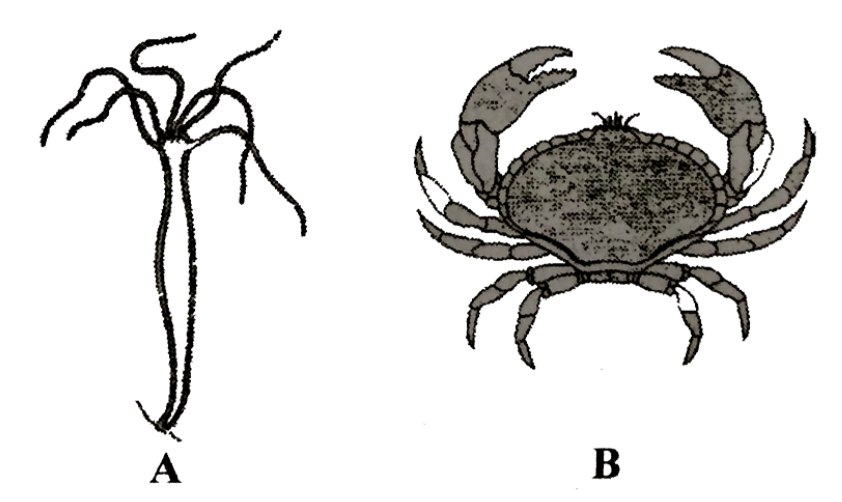
Identify the type of symmetry in the given animal’s A and B

A. A-bilateral, B-symmetrical
B. A-bilateral, B-bilateral
C. A-radial, B-bilateral
D. A-radial, B-radial

Answer
459k+ views
Hint: If a Hydra is cut through the central axis, it produces correspondence or regular body parts. If the scorpion is cut along the middle of the body longitudinally, it produces two equal halves i.e. right and left halves.
Complete answer: Animals are classified on the basis of symmetry of their body plan. On this basis, there are three types of symmetry; radial symmetry, bilateral symmetry and asymmetry. In bilateral symmetry, if there is a line passing through the middle of the body of an animal longitudinally then, there will be two equal halves i.e. right and left half of the body. If a body is cut from the centre or around the central axis, the animal exhibits correspondence or regularity of body parts, which is known as radial symmetry. There is no left and right half in radial symmetry. Asymmetric animals are those animals that do not show any symmetry along any of the axes. ‘A’ in the diagram is Hydra which possesses a radial symmetry and ‘B’ in the diagram is a scorpion which possesses a bilateral symmetry. Radial symmetry animals have top and bottom surfaces, but no left and right sides, or front and back.
Hence, the correct answer is option C.
Note: The body plan of humans, butterflies, wasps, honey bees, etc. and many others possess bilateral symmetry. Bilateral symmetry is also known as mirror symmetry. Corals, jellyfish, starfish and others exhibit radial symmetry. Radial symmetry marks the body plan of phylum Ctenophora.
Complete answer: Animals are classified on the basis of symmetry of their body plan. On this basis, there are three types of symmetry; radial symmetry, bilateral symmetry and asymmetry. In bilateral symmetry, if there is a line passing through the middle of the body of an animal longitudinally then, there will be two equal halves i.e. right and left half of the body. If a body is cut from the centre or around the central axis, the animal exhibits correspondence or regularity of body parts, which is known as radial symmetry. There is no left and right half in radial symmetry. Asymmetric animals are those animals that do not show any symmetry along any of the axes. ‘A’ in the diagram is Hydra which possesses a radial symmetry and ‘B’ in the diagram is a scorpion which possesses a bilateral symmetry. Radial symmetry animals have top and bottom surfaces, but no left and right sides, or front and back.
Hence, the correct answer is option C.
Note: The body plan of humans, butterflies, wasps, honey bees, etc. and many others possess bilateral symmetry. Bilateral symmetry is also known as mirror symmetry. Corals, jellyfish, starfish and others exhibit radial symmetry. Radial symmetry marks the body plan of phylum Ctenophora.
Recently Updated Pages
Master Class 11 Accountancy: Engaging Questions & Answers for Success

Glucose when reduced with HI and red Phosphorus gives class 11 chemistry CBSE

The highest possible oxidation states of Uranium and class 11 chemistry CBSE

Find the value of x if the mode of the following data class 11 maths CBSE

Which of the following can be used in the Friedel Crafts class 11 chemistry CBSE

A sphere of mass 40 kg is attracted by a second sphere class 11 physics CBSE

Trending doubts
10 examples of friction in our daily life

One Metric ton is equal to kg A 10000 B 1000 C 100 class 11 physics CBSE

Difference Between Prokaryotic Cells and Eukaryotic Cells

State and prove Bernoullis theorem class 11 physics CBSE

What organs are located on the left side of your body class 11 biology CBSE

The combining capacity of an element is known as i class 11 chemistry CBSE




